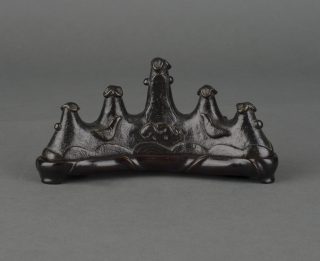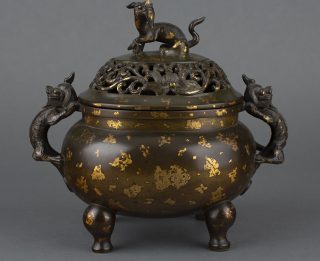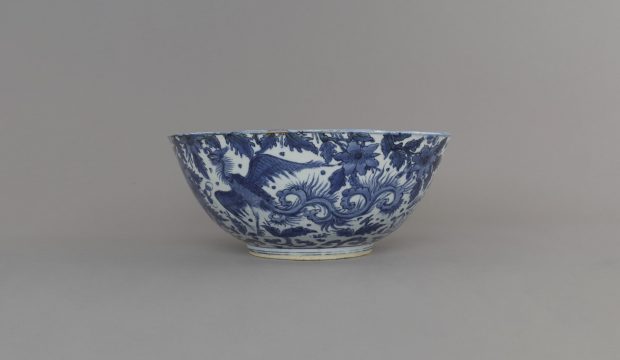What is Ming Dynasty Art?
Ming art is amongst the most revered and sought-after of all Chinese artwork.
After almost a century of rule by the Mongol-led Yuan dynasty, the reestablishment of the indigenous Han Chinese ruling house in 1368 heralded a quite remarkable period of artistic, cultural and creative expansion and restoration.
The Ming dynasty’s first emperor, Hongwu, recognised that traditional Chinese art had been somewhat overlooked in favour of the intricate and highly detailed – some would say ‘busy’ – Mongol styles, heavily influenced by art from the Islamic world. So much so that he effectively recruited the finest purveyors of Ming dynasty artwork into the Imperial court and instructed them to return to more realistic, didactic representations, emulating the styles from the Tang and Song dynasties, especially from the Southern Song’s Imperial Painting Academy.
He favoured great landscapes, compositions including flowers and birds and figural narratives as depicted in Chinese literature that he believed would glorify the new Ming dynasty and convey its majesty, virtue and benevolence.
Of course when we talk about Ming dynasty artwork we don’t just talk about painting and porcelain. By the beginning of the fifteenth century, the Ming empire had become prosperous and stable and as such, was characterised by lofty imperial ambition and political, material and creative achievement and Ming art encompasses architecture, calligraphy, literature and poetry, decorative arts and crafts and jewellery.
Ming Dynasty Art – Decorative Arts & Crafts
Early Ming artists built on the rich and varied legacy of the Yuan which took influence from both traditional forms of Chinese art as well as foreign styles but as the dynasty took hold, the Ming artists were bound by a strict set of rules regarding style and standards that maintained quality and safeguarded what was exported out of the country.
The main types of Ming dynasty artifacts included horn and ivory carving, cloisonné (a technique for decorating metalwork pieces with materials of different colours either separated or held in place by – usually gold – wire), jade carvings, silks and textiles, jewellery, gold work and lacquerware. It was in these areas that Ming dynasty artwork became famous the world over.
Ming Art – Painting
This form of Ming dynasty art further developed techniques and styles from the Song dynasty as well as the most famous Ming artists creating many new styles and techniques. During the early Ming period, the dominant schools were the Zhe and the Yuanti, both heavily influenced by the Southern Song’s Imperial Painting Academy.
Between around 1465 and the mid-1560s – known broadly as the mid-Ming period – the Zhe and Yuanti schools declined in popularity and in their places the Wu school became the nation’s most dominant. The Wu Ming artists developed the Yuan scholar-artist style to its zenith and the most famous Ming artists of this period included what became known as the ‘Four Masters’ – Shen Zhou, Tang Yin, Wen Zhengming and Qiu Ying. Other famous creators of Ming dynasty artwork included Ni Zan, Dong Qichang, Xu Wei who developed Xieyi, or ‘enjoyable style’ and Chen Chun who followed the Wu principles but then developed shan shui, or a style of landscape painting.
Towards the end of the dynasty, the most famous Ming artists were part of the Songjiang and Huating schools of Ming dynasty art.
Ming Dynasty Jewellery
Often overlooked as classic Ming art in favour of porcelain and paintings, jewellery from the Ming dynasty was intricately beautiful and laden with symbolism. The jewellers creating these stunning pieces of Ming dynasty art primarily made pieces for the Imperial court and, on occasion, for other members of the aristocracy and nobility or for Taoist and Buddhist temples. Guilds were formed to protect the integrity of the profession as well as protecting the rights of the jewellers themselves. It was a profession that was incredibly well looked after.
The most common materials used by Ming dynasty jewellers were gold, silver and jade and some of the most famous pieces of Ming art are hairpins. Using filigree, the art of twisting together extremely thin and delicate strands of precious metal, hairpins were revered for their sheer complexity and the level of design and detail represented the status of the lady it adorned. Embedding gemstones imported from southeast Asia into filigree work was a technique mastered by the makers of this Ming dynasty art and these pieces are amongst the most ornate and beautiful of all Ming dynasty artifacts.
Mostly made for members of the Imperial court, Ming dynasty artwork included headdresses, belts, brooches, trinkets and ornaments and were all worn to denote status and rank. The more intricate and detailed, the more important the wearer.
The Most Famous Ming Dynasty Artifacts
Ming art is so rich and varied, it’s extremely hard to choose individual pieces as representations of the very best Ming dynasty art. During the last decades of the dynasty, polymath Chen Hongshou, one of the most famous of all Ming artists, flourished. Known by his courtesy name Zhanghou, he was also a skilled calligrapher, poet and writer or prose and he created some of the most beautiful of all Ming dynasty artifacts, including his masterpieces Shui Hu Ye Zi and Bo Gu Ye Zi.
When we discuss Ming dynasty artifacts, we must mention two of the most famous pieces of Ming dynasty art – the ‘fishpond’ bowl and the Meiyintang Chenghua ‘Chicken Cup’.
Made during the reign of the Emperor Xuande (1425 – 1435), the ‘fishpond’ bowl has been described as ‘one of the greatest examples of early Ming blue and white porcelain in private hands’. This stunning piece of Ming art is a small, 23cm lobed bowl painted in underglaze blue. It depicts a number of fish swimming in a lotus pond including carp and traditional Mandarin fish but also the fangyu, a type of bream that is not often depicted on this type of Ming dynasty artwork.
Fish themes depicted in Ming art have great cultural and philosophical significance and the narratives can be read in the Daoist allegories and parables that were incredibly popular during the reign of the Ming emperors.
This incredibly rare (and possibly unique) piece of Ming dynasty artwork is six centuries old but remains in an extraordinarily good – almost perfect – condition, a testament to the quality of the craftsmanship. It was put up for auction in 2017. So dearly coveted, it sold for almost £23,000,000.
Mostly held in museums but with a very small number in private collections around the world, the famed 500 year-old Meiyintang Chenghua ‘Chicken Cup’ is alleged to be one of only seventeen in existence and is considered to be the ‘holy grail’ of Ming dynasty artwork.
It is a very small white doucai or ‘contrasting colours’ cup decorated with a continuous scene of a red rooster and his hen tending to their young. It was made between 1464 and 1487 during the reign of the Emperor Chenghua during a perfect storm when both the quality of Ming art was at its absolute finest and the quantities produced were very small. As such, these small chicken cups are amongst the most famous and revered of all Ming dynasty art.
In 2014, Meiyintang Chenghua ‘Chicken Cup’ sold for £21,500,000.



















